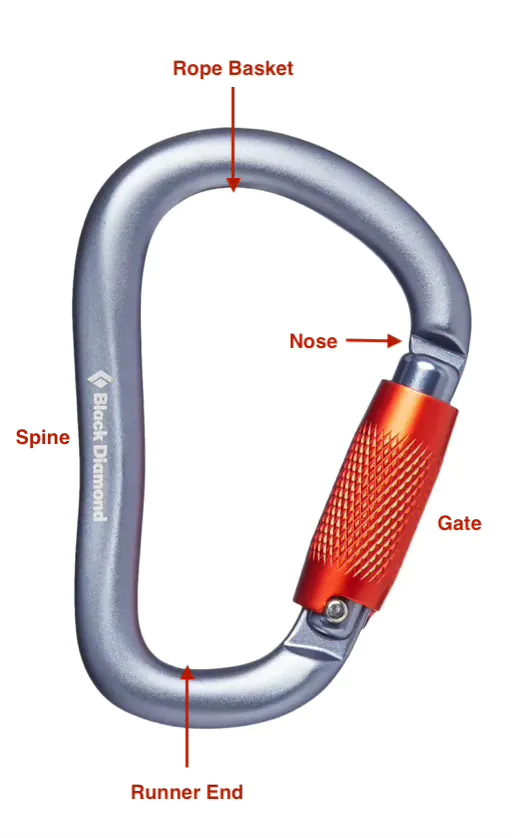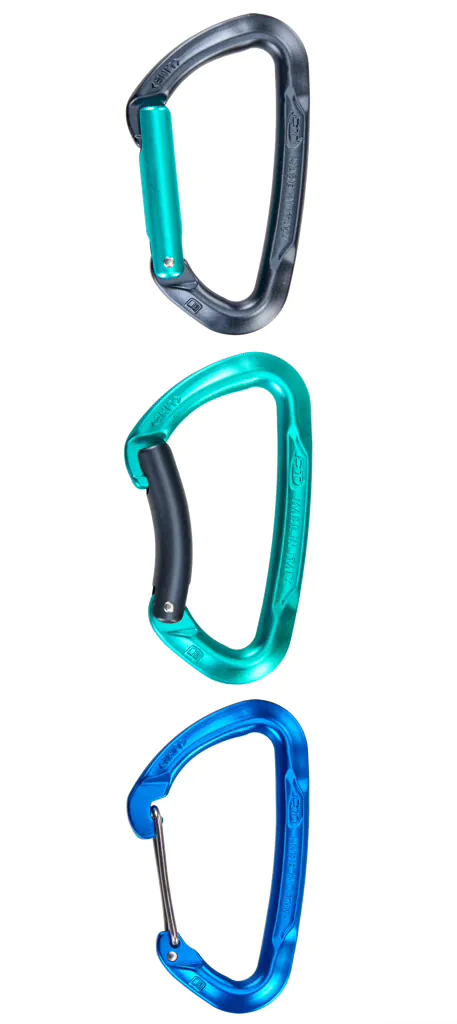Carabiners
So many to choose from!
Different climbing tasks require different kinds of carabiners. This is why there are so many types available: locking, non-locking, HMS, screwgate, twistlock, non-load-bearing accessory carabiners...
To choose and use them properly, we must first understand the differences between them. There are four main areas to consider:
- Type
- Shape
- Gate type
- Size, weight and strength
| Use | Carabiner type |
|---|---|
| Belaying and rappelling | Large pear-shape (HMS) locking carabiners |
| Anchors and securing | Asymmetric D locking carabiners |
| Sport-climbing quickdraws | Asymmetric D carabiners with any gate type |
| Trad-climbing quickdraws | Asymmetric D carabiners with wiregates |
| Pulleys and hauling | Oval locking carabiners | Gear racking | Go for lightest and most comfortable |
Carabiner anatomy
Gate - the spring-loaded pivoting piece opposite the spine. The gate swings shut to close against the nose. Gates can be solid (straight or bent), or wire, and can have a locking mechanism: screw-lock, or auto-lock.
Spine - the long section of the carabiner opposite the gate that has the strength ratings, certifications, and brand stamped on it. When a carabiner is under weight, most of the force is directed to the spine, which is the strongest individual section of the carabiner.
Rope Basket - the large bend at the top of the spine that the rope runs through. This open curve minimises wear on the rope and the carabiner.
Runner End - this is the smaller bend opposite the rope basket in which the anchor hole, belay loop, webbing or anything else stationary would be positioned.
Nose - at the top of the opening for the gate, this is where the gate is latched while closed. Some are notched to accept wire gates, but the keylock style is smooth, which prevents the biners from snagging on bolts and gear when cleaning.

Carabiner types
There are three main types of carabiners:
- Non-load-bearing - accessory - carabiners,
- Basic or normal carabiners, a.k.a. non-locking carabiners,
- Locking carabiners.
Accessory carabiners come in all shapes and sizes, and are used to attach small items (like a chalk bag, climbing shoes, or a bottle) to your backpack or harness.
Ice screw clips are a special type of accessory carabiner - they are essential for securely and comfortably storing ice screws on the harness and are clipped to the dedicated ice screw clip attachment points.
Accessory carabiners should not be used for climbing - most of them are not certified as personal protective equipment against falling (but this Grivel Carryabiner is certified)!

Carabiner shapes
Asymmetric D (offset D)
The most popular carabiner shape, they are slightly shorter at the gate side to reduce weight, and have larger gate openings than regular Ds, which makes clipping them even easier. But they don't have as much inside room as similarly sized Ds or ovals and are slightly less strong than regular Ds (though still plenty strong).
D Shape (regular D)
These are excellent for most climbing tasks. It's the strongest carabiner shape, as they hold the load off-center toward the stronger, non-gated side, so a smaller and lighter D carabiner can be just as strong as a larger oval. They also have larger gate opening than oval shaped carabiners.
Pear (HMS)
Pear-shaped carabiners have large gate openings and are used primarily for belaying and rappelling, but also can be used at anchor points. They are often called HMS carabiners, due to having a wide, more symmetrical top (rope basket) that works well with a Münter hitch. These carabiners are heavier and more expensive than other shapes, while being weaker than D and asymmetric D shapes.
Oval
Oval carabiners are the OG shape. They're versatile and affordable, though have smaller gate opening, are heavier and weaker than other shapes. Oval carabiners have smooth, uniform top and bottom curves to limit load shifting. They offer more gear-holding capacity than other shapes and their symmetry permits them to be used for carabiner-brake rappels. Often used with pulleys, their place is in a crevasse rescue kit, and in aid climbing because they centre the loads at their curve.

Gate types
Straight Gate
Solid straight gates are strong and easy to use. Carabiners with straight gates are found on quickdraws and are often used for racking gear. Most feature a keylock nose - a smooth notch where the nose of the carabiner and the gate interact, which prevents the carabiner from catching on rope, gear loop, bolt hangers, slings, etc.
Bent Gate
Solid bent gates have a concave shape that makes clipping a rope quick and easy, and are most often found on the rope-end of quickdraws. Bent gate carabiners can also feature a keylock nose.
Wiregate
Wiregate carabiners use a loop of stainless steel wire for a gate, which decreases overall weight and eliminates the need for extra parts found in conventional gates. Wiregate designs also allow for larger gate openings. They are less likely to freeze up than other gate styles in cold, wet weather. Although wiregates don't appear as strong as conventional styles, most are. Also, due to the lower mass in the gate itself, wiregates are less likely to vibrate open during a fall (gate lash/flap).

Locking gate carabiners
Locking carabiners have gates that can be locked in the closed position to provide extra protection against accidental gate openings. They feature either a manual (a.k.a. screw-lock), or auto-locking system.
Screw-lock gates require the user to manually screw the sleeve onto the gate to lock it.
Auto-lock carabiners automatically lock whenever the gate is closed. These require two (twin-lock), or three (triple-lock) actions to open the gate. There are other, less common auto-locking systems: twin-gate (Grivel), slider gate (Edelrid), and ball-lock (Petzl).
Locking carabiners, though heavier than non-locking ones, are the only choice for using with a belay/rappel device. You should also consider using them at belay stations and at critical protection placements. They offer a more secure attachment and enhance your peace of mind.

Carabiner size, weight and strength
Carabiner Size
Large carabiners are typically easier to handle and clip, and they can hold more gear inside. They are commonly used with belay and rappel devices.
Smaller carabiners are lighter and take up less room on your rack, but they can be harder to clip and manage with gloves due to smaller size, and smaller gate opening.
Gate opening - maximum width that the gate can open - is crucial when choosing a carabiner. Too little or too big opening makes working with a carabiner more difficult. The ideal clearance is individual, and should be tested out by the user.
Carabiner Weight
The less weight you carry while climbing - the better. But superlight carabiners are often smaller in size, which can make them harder to use. Look for a good balance between weight and comfort, bearing in mind their purpose.
Carabiner Strength
Carabiners are rated for strength in three directions: lengthwise, sideways and while open. These ratings are marked on the spine of the carabiner. All climbing carabiners must pass UIAA and CE certification, meaning they are all strong enough if used correctly.

